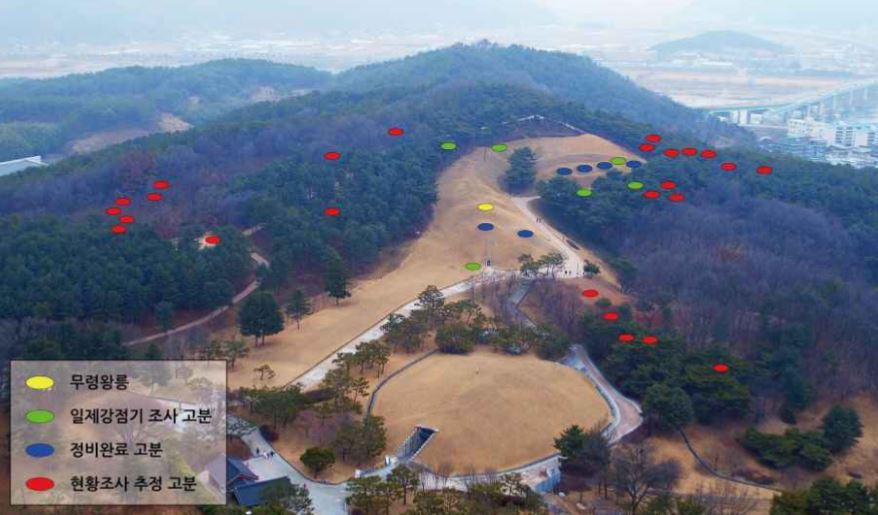A state-run research center has found traces of 41 Baekje-era tumuli near the tomb of King Muryeong in Gongju, some of which could turn out to be newfound royal tombs, the Cultural Heritage Administration said Wednesday.
The discovery was made during research conducted as part of a long-term study on the tumuli at Songsan-ri -- part of the UNESCO World Heritage Site known as the Baekje Historic Areas -- according to the CHA affiliate the Buyeo National Research Institute of Cultural Heritage. The tumuli are thought to belong to members of the royal family and nobility of the Baekje Kingdom (18 BC-AD 660).
Unlike the Silla and Gaya kingdoms, which coexisted on the Korean Peninsula along with Baekje, Baekje tumuli were hard to identify until recently as the people of Baekje did not create large mounds and the tombs were mostly underground.
The discovery was made during research conducted as part of a long-term study on the tumuli at Songsan-ri -- part of the UNESCO World Heritage Site known as the Baekje Historic Areas -- according to the CHA affiliate the Buyeo National Research Institute of Cultural Heritage. The tumuli are thought to belong to members of the royal family and nobility of the Baekje Kingdom (18 BC-AD 660).
Unlike the Silla and Gaya kingdoms, which coexisted on the Korean Peninsula along with Baekje, Baekje tumuli were hard to identify until recently as the people of Baekje did not create large mounds and the tombs were mostly underground.

Researchers found traces of tumuli Nos. 7, 8, 9 and 29, for which records had been lost after the tumuli were reportedly discovered between 1927 and 1933 when the Korean Peninsula was under Japanese colonial rule. Of the 29 tumuli discovered during those years, records remain for only eight.
While previous research established that royal tombs existed in this area, King Muryeong’s tomb is the only one whose occupant researchers have been able identify.
The Buyeo institute also found “jungbang” bricks -- similar to eight of the bricks found in King Muryeong’s tomb, which were used to form the shape of a window.
Because the bricks were found 80 meters away from King Muryeong’s tomb and 70 meters away from tumulus No. 17, a brick-based tomb that was already known to archaeologists, researchers say it is possible that another brick-based tomb may be in the area.
“Most of the research on the tumuli in Songsan-ri had been conducted by the Japanese, and not much follow-up study has taken place since then. This research is very meaningful because it has been done by us (Koreans) with a systematic plan,” the CHA said.
By Yoon Min-sik
(minsikyoon@heraldcorp.com)


















![[KH Explains] Hyundai's full hybrid edge to pay off amid slow transition to pure EVs](http://res.heraldm.com/phpwas/restmb_idxmake.php?idx=652&simg=/content/image/2024/04/18/20240418050645_0.jpg&u=20240418181020)

![[Today’s K-pop] Zico drops snippet of collaboration with Jennie](http://res.heraldm.com/phpwas/restmb_idxmake.php?idx=642&simg=/content/image/2024/04/18/20240418050702_0.jpg&u=)